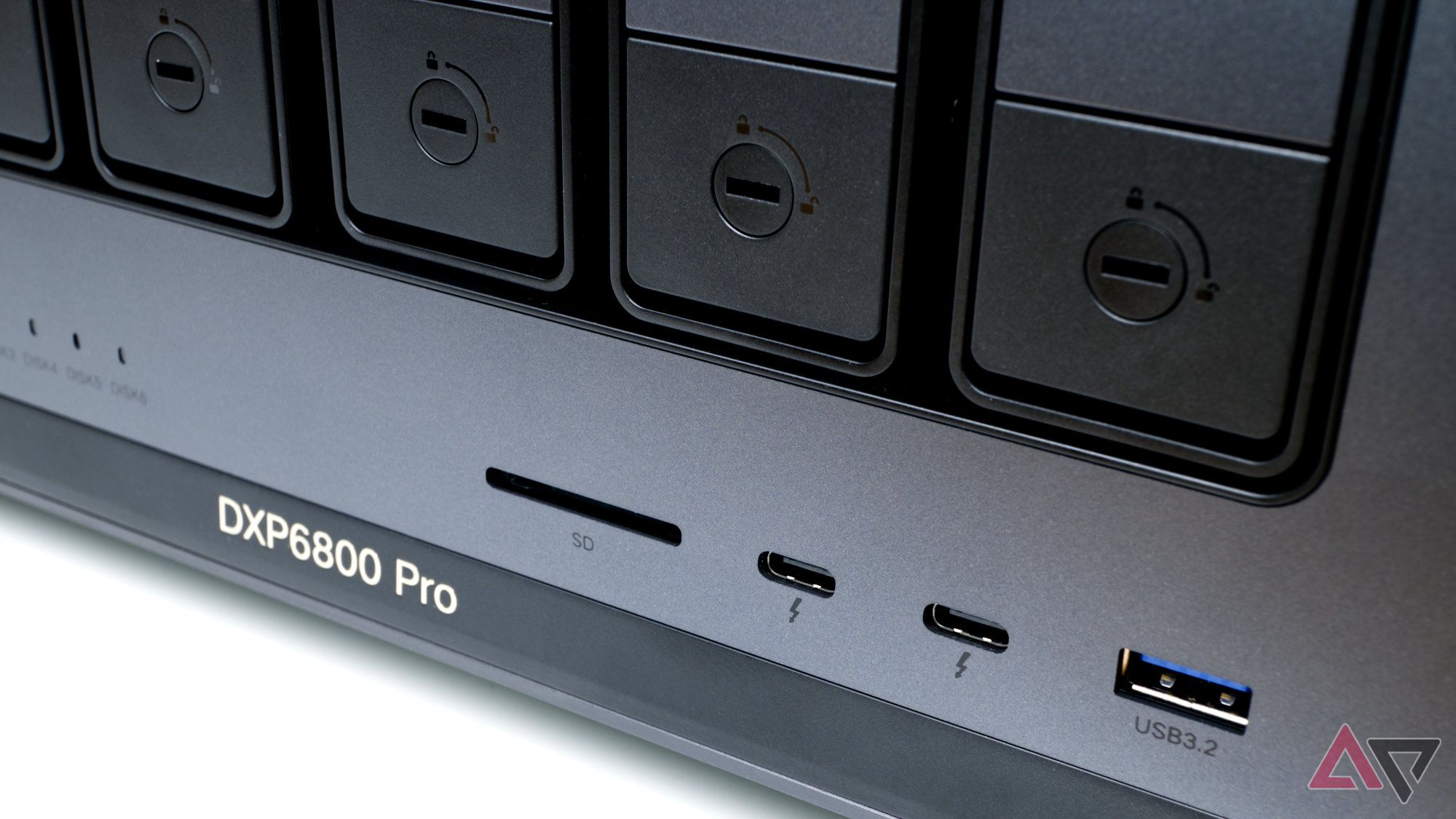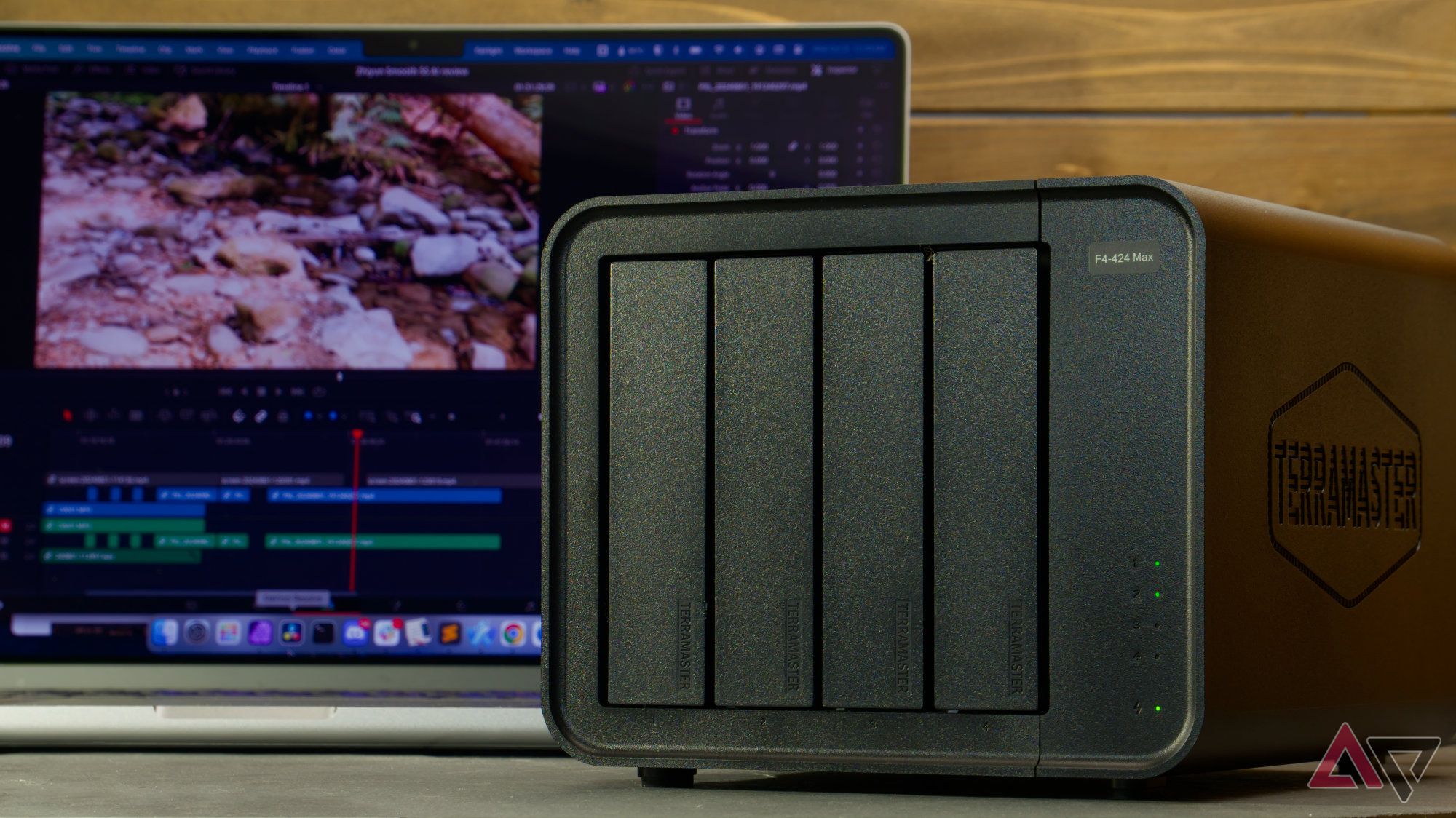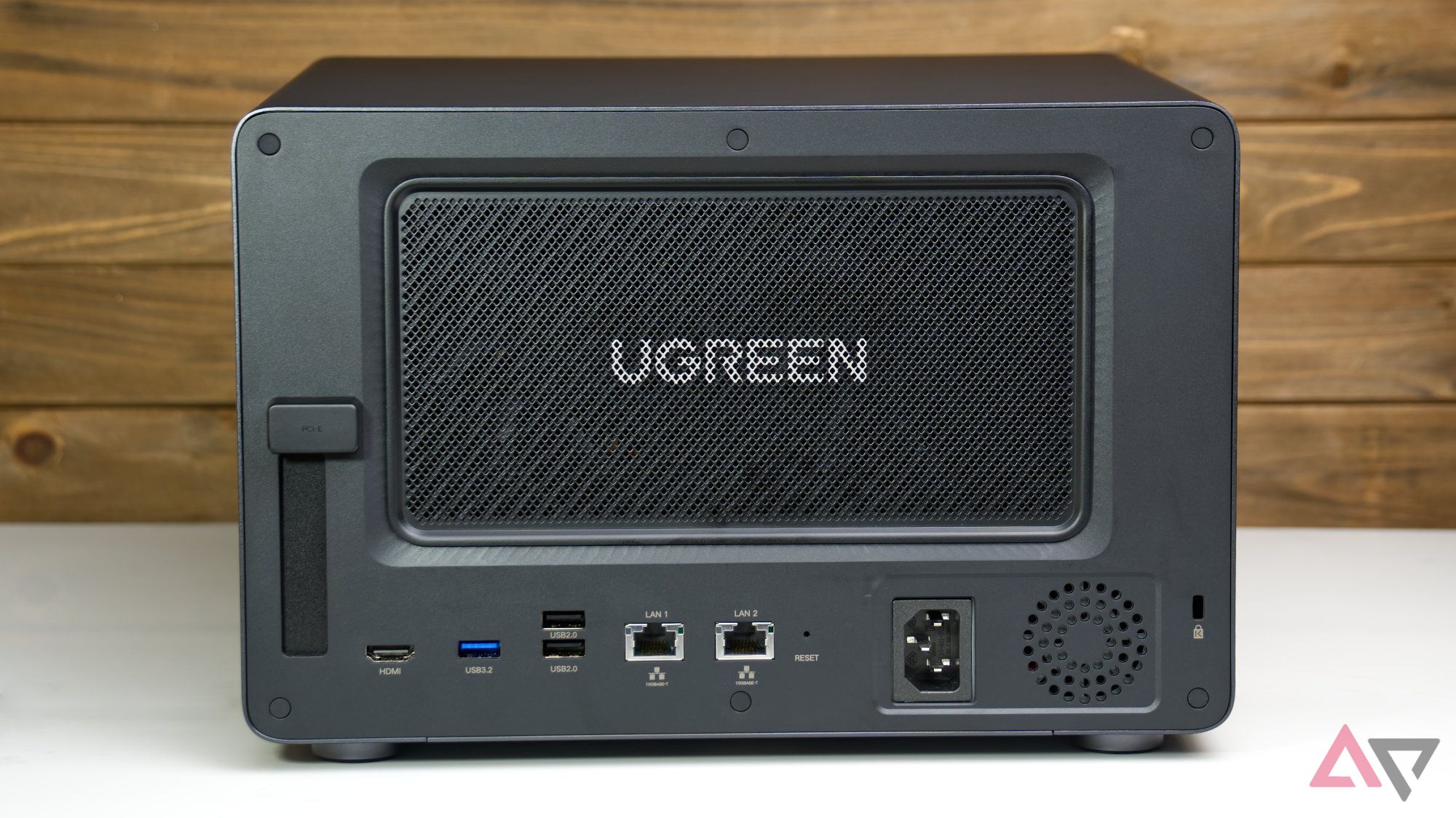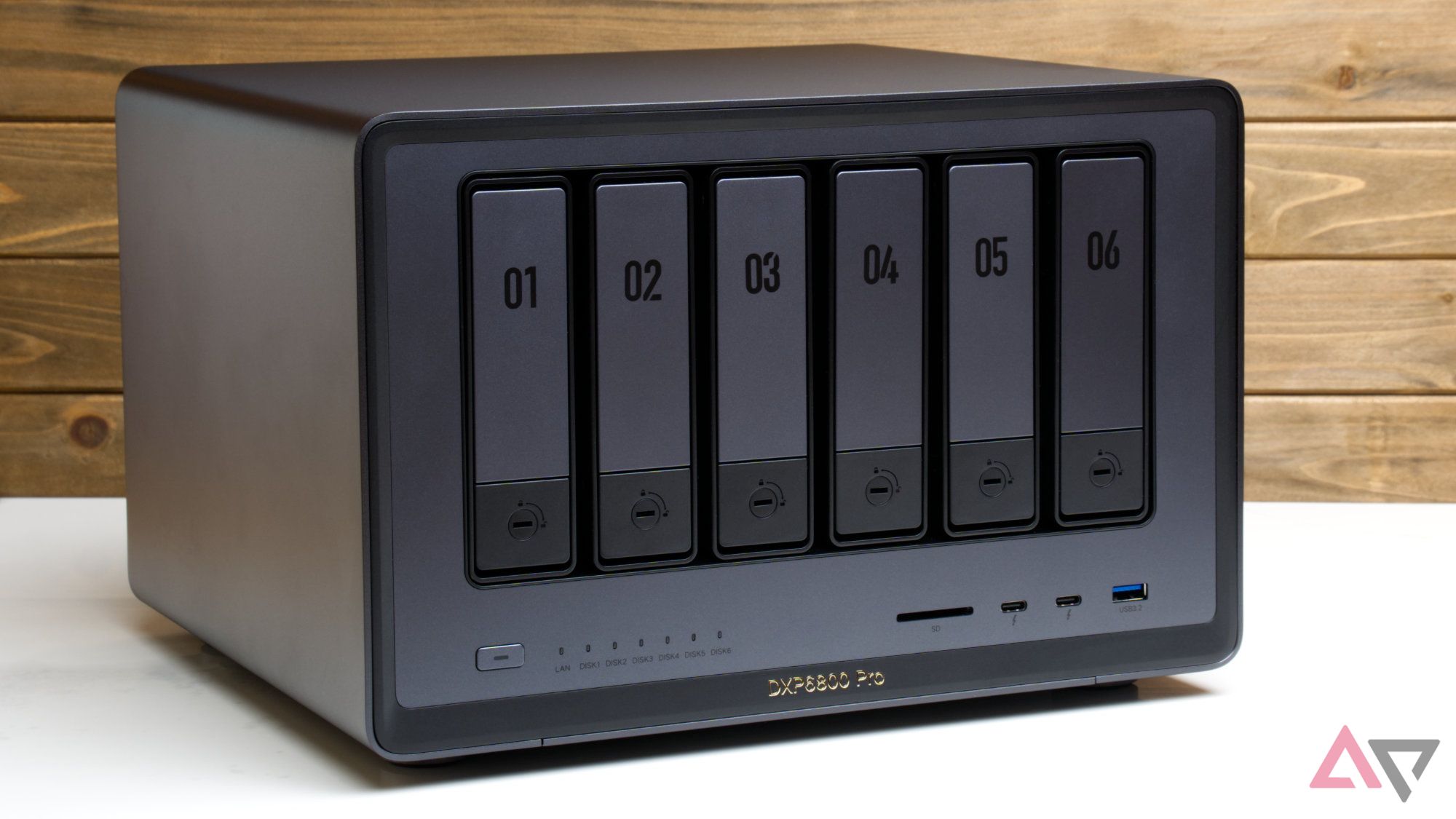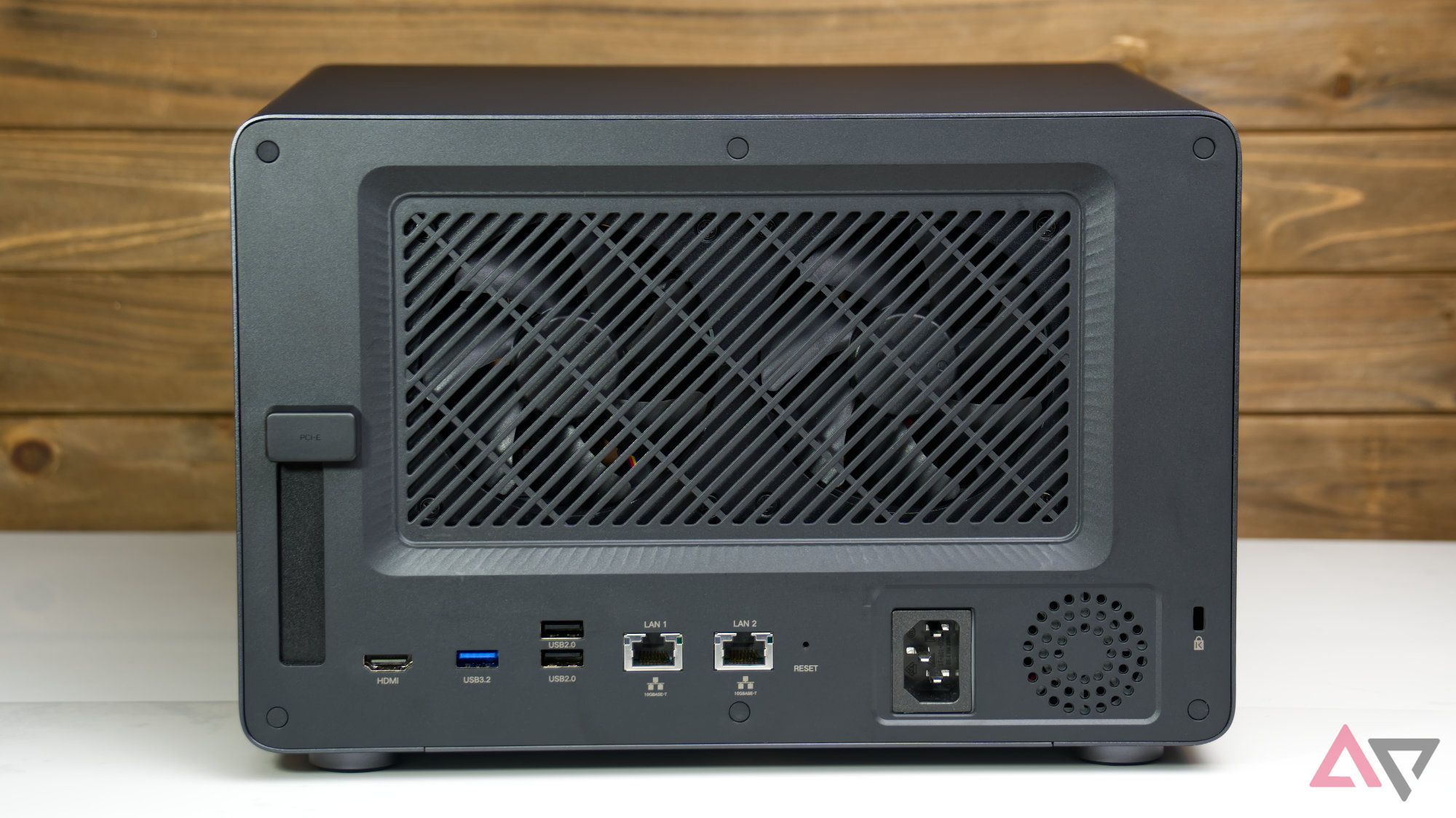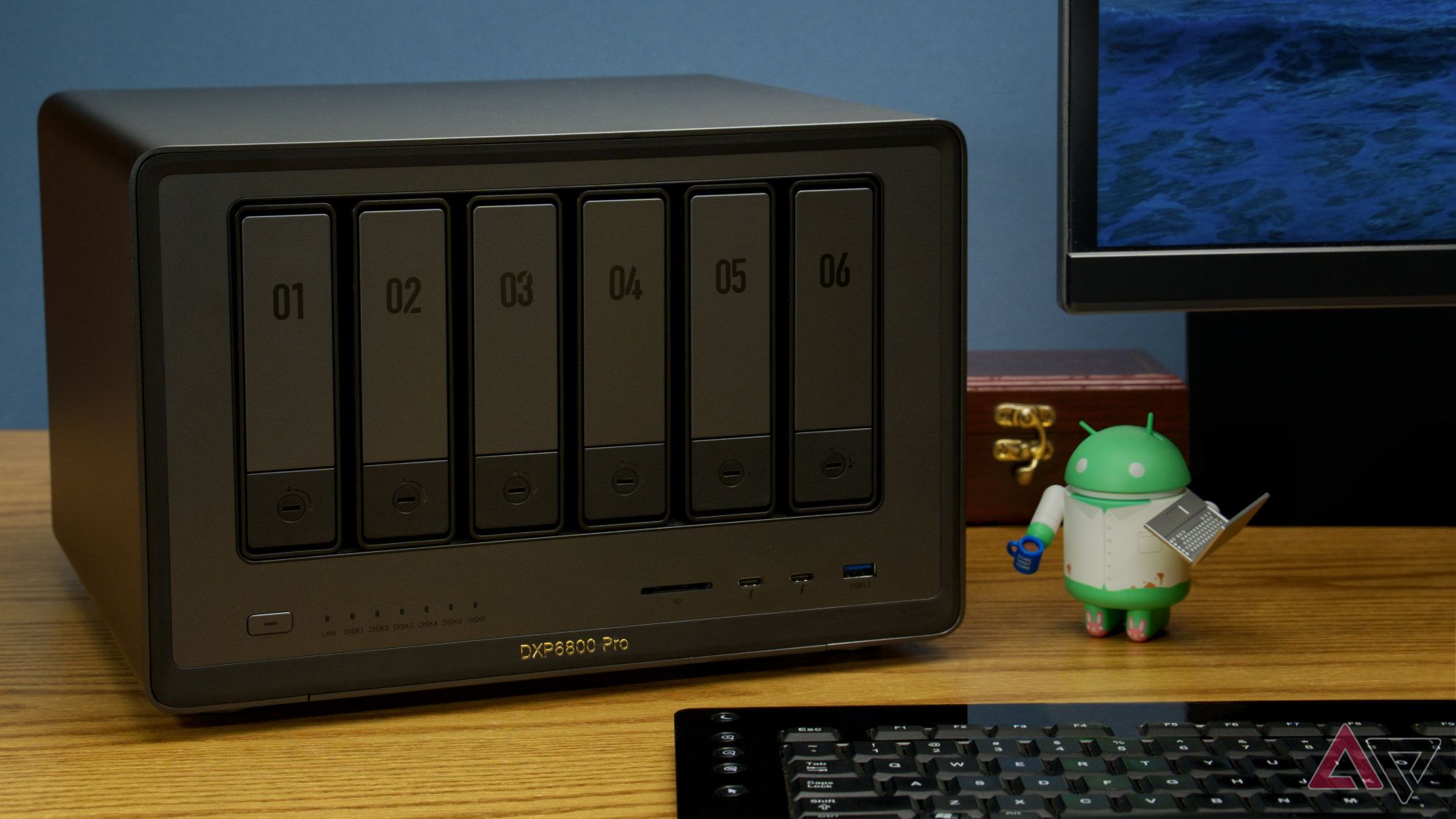You probably know Ugreen for its great power banks and USB chargers, which have earned a pretty positive reputation over the years. It might seem a little out of left field, but the same company is breaking into the NAS market, and making quite a compelling entry on the first attempt.
The NASync DXP6800 Pro has bays for six SATA drives, two NVMe sticks, tons of ports, and even a PCIe slot for adding more. It’s a beast of a machine with a high-performance processor and plenty of speed for some of the most demanding tasks. The software is still growing and evolving, but it’s looking good in its current state and continues to improve.
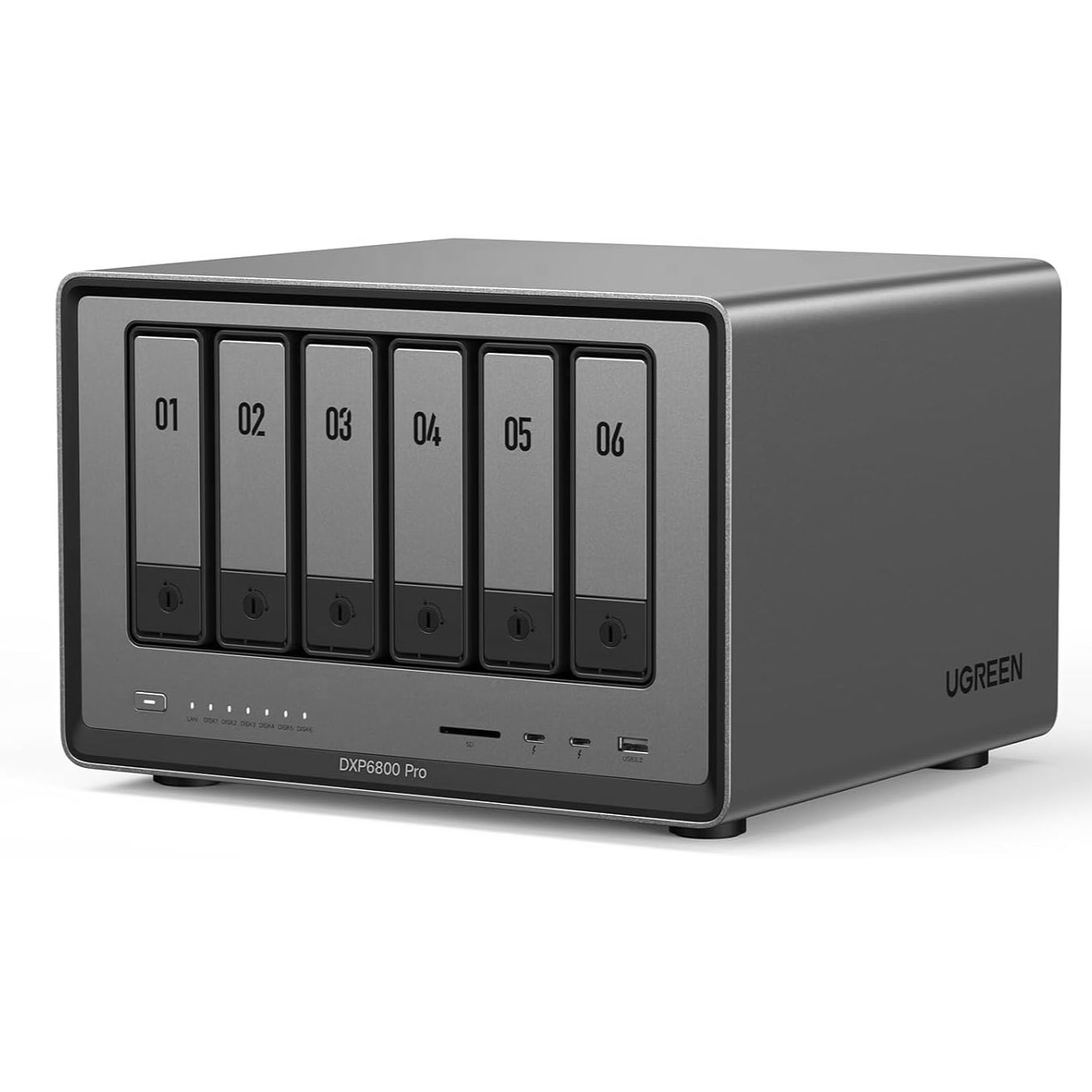

Ugreen NASync DXP6800 Pro
The Ugreen DXP6800 Pro is a 6-bay NAS packed with a powerful Intel Core i5-1235U processor and supports up to 64GB RAM. There are two additional M.2 SSD slots that can be used for caching to improve read/write performance or provisioned for additional storage. There are plenty of ports, including two 10GbE, two Thunderbolt 4, four USB-A (split between 3.2 and 2.0), an SD card reader, and an HDMI port capable of 8K output for playback of common media files.
- Powerful CPU with iGPU, and support for lots of RAM
- Lots of ports and drives, plus expansion potential
- Really promising software experience with some great features
- A bit larger than a comparable NAS chassis
- Software is still a work in progress
Price, availability, and specs
Ugreen originally launched a Kickstarter to fund its first NAS model line, but seeing as they were fully built, and production models were already going out to reviewers, that was really just a marketing and preorder strategy. At this point, you can now order any NASync model directly from Ugreen’s own online store, or through Amazon and B&H.
The DXP6800 Pro is priced at $1,200, but there are models available in different sizes and specs to suit other price points.
What’s good about the Ugreen DXP6800 Pro?
An absolute beast
The specs alone tell quite a story about the DXP6800 Pro. For starters, it has a powerful Intel Core i5-1235U chip, which also appeared more recently in the TerraMaster F4-424 Max. And like that machine, Ugreen ships it with 8GB of RAM, but it can be upgraded to 64GB. These specs alone are well-positioned for anyone planning to run demanding applications, like virtual machines or servers.
The port selection is where things quickly get interesting. It starts with two 10GbE ports on the rear, which is pretty standard for a system like this; but there are also two USB-A 2.0 ports, a USB-A 3.2 port, and an HDMI port (more on that later). A PCI-e x4 slot even allows for expansion card installation to add more Ethernet ports or SSDs. There’s a compatibility guide indicating models that have been tested.
Now, we turn our attention to the front, where you’ll find another USB-A 3.2 port, two USB-C Thunderbolt 4 ports, and an SD card reader. Yes, that’s six USB ports of varying shapes and speeds in total.
It has a lot of ports and expansion potential, and I love to see it. How much use they’ll get is hard to judge, and most people probably won’t need all the ports in use at once. On the other hand, this is great for photography studios and video production houses with stacks of drives and memory cards that need to be offloaded and backed up ASAP.
Of course, there are also six SATA drive bays and two M.2 NVMe slots. Ugreen’s OS supports several flexible RAID options, and the M.2 drives can be used either for R/W caching or provisioned in the storage pool with the other SATA drives. Collectively, there’s a pretty high-performance ceiling to work with.
Otherwise, the DXP6800 Pro’s physical design looks and feels nicer than many NAS boxes I’ve seen, largely thanks to simple aesthetic details and a unique look that others lack. The shell feels like sturdy metal, and there’s a magnetic filter on the back to cover the intake fans. I find it oddly satisfying that the drive LEDs “breathe” when the drives are idling, which brings to mind the appearance of lit-up server racks in movies. It just feels like Ugreen considered how to make this unit attractive when it’s visible, rather than just another bland box hidden away in a server closet or basement.
So the specs are great, but like any other NAS, the hardware is pretty straightforward. What about the OS? Ugreen isn’t just brand new to the NAS market, it has never sold products with a crucial software component before — let’s not count the little bits of firmware in power banks and chargers. A NAS operating system doesn’t have to be as complicated as smartphone and desktop platforms, but it’s not a small undertaking, either.
Having said that, I’m really quite pleased with UGOS. Okay, the name, obviously short for Ugreen OS, sounds a bit unflattering. Otherwise, I like what I’m seeing out of Ugreen’s software development efforts.
I’ve been using the DXP6800 Pro and DXP480T Plus (review coming soon) for a while, starting back when there were quite a few critical features missing, and I’ve watched a really impressive update progression that has filled in most of the gaps and fixed a lot of bugs. UGOS still has some rough edges here and there, but the same could be said for TerraMaster’s TOS platform.
Like all the other NAS products out there, the primary way to manage UGOS is through a browser-based interface resembling a desktop OS. Ugreen has given the UI some clever details, like title bars that match the OS you’re connecting from. For example, macOS users will see the traffic lights in the top-left corner while Windows users will see their buttons at the top-right.
Bugs and glitches were fairly common in the early days, but I don’t recall seeing anything of consequence misbehaving in a long time, and any remaining issues I’ve spotted have been pretty minor and infrequent.
There is also a smartphone app; besides a few more rough edges, it’s extraordinarily good. The design closely resembles the web interface, but it has a clean layout that is appropriate for smartphones, and it’s pretty intuitive to navigate.
In fact, I dare say I like it more than the competition for a simple reason: I can do so much in a single app. Some companies like TerraMaster enable some control over a NAS with a single smartphone app, but it’s more limited. Meanwhile, Synology allows you to do just about everything through your smartphone but requires many separate apps, each with its own limitations and behaviors.
There would be too many features to discuss in this review, but as a quick overview, UGOS provides most of the typical services and apps people often look for in a NAS. For example, user accounts support private storage with individual access over network shares; there are file and download managers, a universal search tool, and some basic sync capabilities. There’s also a photo storage app that can do AI-based management, music, and video apps for streaming media to a phone and a text editor. The one thing that comes to mind that I haven’t seen is support for third-party sync services like Dropbox and Google Drive, which would be nice for local backups.
For anything that’s not included, UGOS can now run Docker containers, which wasn’t originally true. There is also support for running virtual machines, which I assume is based on VirtualBox, though the interface is still pretty minimal.
One specific hardware feature I want to call back to is the HDMI port. I often call out TerraMaster for having an HDMI port that’s only useful for diagnosing boot issues or maybe running limited shell commands, so I’m pleased to say that Ugreen’s port can actually be used to play video. It’s not a perfect implementation — there’s currently no way to use it from the web interface, only the app — but it’s great to see this is something Ugreen is doing.
And finally, for anybody interested in replacing the OS, it’s worth mentioning that Ugreen has also opened up its policies to allow third-party operating systems without voiding the warranty.
What’s bad about the UGreen DXP6800 Pro?
Power and features come at a cost
For the most part, I like how UGOS works, but it is still young, and some unavoidable truths come with it. For starters, it’s obvious that there aren’t as many settings, tools, or features, and certain shortcomings might be non-starters for some users or businesses. Many control panel screens are half-empty compared to similar sections on competing platforms. Ugreen has been very responsive to customer requests, and it feels like a safe assumption that the remaining gaps will be filled in with time, but how much time is the question?
Trust in the OS is also worth questioning. I haven’t had any specific reasons to doubt Ugreen’s software quality recently, but any platform that hasn’t been extensively battle-tested for security and integrity could be vulnerable to more risk factors than a mature platform.
I’m also unclear about the app situation. Ugreen’s App Center has apps to download, but the list is currently pretty short at twenty listings, and they all list Ugreen as the developer — even on the Docker app. You won’t find staples on here like Plex, a git server, or Java. I haven’t seen any SDKs for building apps to target UGOS or a process for submitting them to the App Center, and there’s no way to tell when or if that will be possible. In the meantime, the only practical solutions to run third-party software is Docker or a virtual machine. That’s fine for the right customer or business, and may even be better in some ways, but it requires more knowledge, skill, and time to get things configured properly.
While I suggested earlier that the box looks nicer than most of the competition, you still probably won’t want it out in the open. Why? It’s the fans, always the fans. Just about every consumer NAS produces fan noise; it’s just part of the deal for a fairly powerful processor and several spinning mechanical drives. These aren’t the loudest fans I’ve heard, but they’re loud enough to stand out in an otherwise quiet room. I doubt it would be noticeable in a stereotypical office environment with several people and other equipment, but it could be annoying in a home office or other quiet spaces.
And finally, one wish list item I’d like to see is USB peripheral mode supported by UGOS. This is where you could plug a computer into one of the DXP6800 Pro ports, and it would behave like an external hard drive — basically a DAS (Direct-Attached Storage). This seems to be a rare feature, as I’ve only heard it’s offered on some QNAP models, but I would certainly see some value here. It would reduce the need for overpriced 10GbE adapters when a low-cost USB 3.2 cable could match or exceed the speeds.
Should you buy it?
A pricey risk, but a pretty good one
The DXP6800 is an incredibly beefy system, packed with some pretty powerful specs, plenty of ports, and even some expansion potential. Ultimately, any complaints I have about the hardware are just nitpicks. While $1,200 is not a low price tag by any means, it makes sense when compared to the similarly equipped TerraMaster F4-424 Max at $900 with the same Core i5-1235U CPU and RAM, but two fewer drive bays, roughly half the ports, and no PCI-e slot or SD card reader. Of course, if this price is too lofty, don’t forget that the smaller and lower-spec variations are available, while still being pretty similar.
The included software is where things get complicated. I don’t think it’s bad at all, and if your needs are fairly simple, and if you’re not too concerned with security, Ugreen’s operating system is probably fine.
However, if any of those are deal-breakers, it’s probably better to look toward more established and mature brands like Synology. Alternatively, don’t forget that Ugreen allows the OS to be replaced without voiding the hardware warranty, meaning you can buy this for the hardware while using a more battle-tested alternative like TrueNAS or Unraid.


Ugreen NASync DXP6800 Pro
The Ugreen DXP6800 Pro is a 6-bay NAS packed with a powerful Intel Core i5-1235U processor and supports up to 64GB RAM. There are two additional M.2 SSD slots that can be used for caching to improve read/write performance or provisioned for additional storage. There are plenty of ports, including two 10GbE, two Thunderbolt 4, four USB-A (split between 3.2 and 2.0), an SD card reader, and an HDMI port capable of 8K output for playback of common media files.
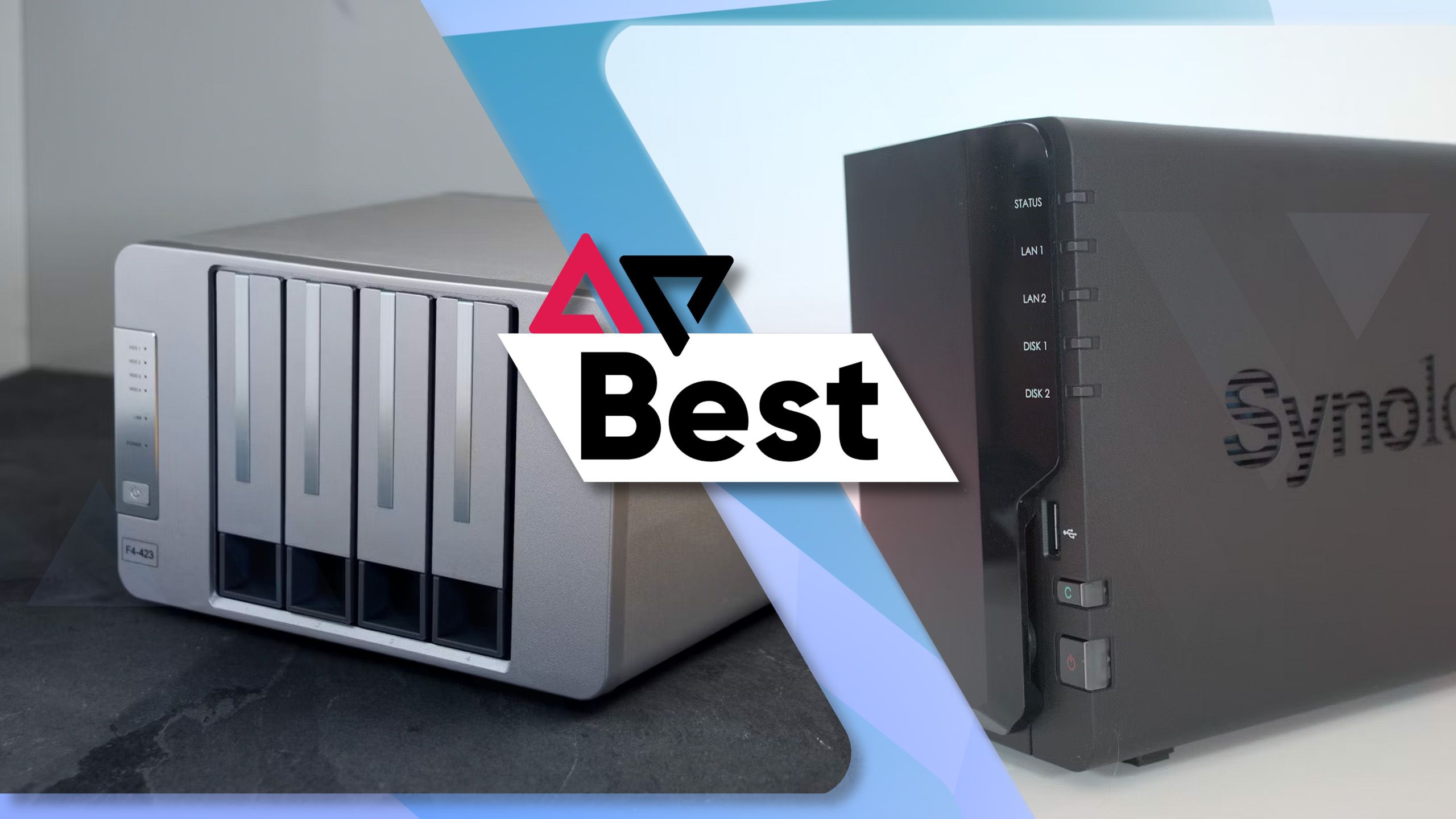
Related
Best NAS devices in 2024
Looking to handle your own backups and media streaming? These are the very best NAS for home, work, and play




